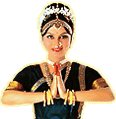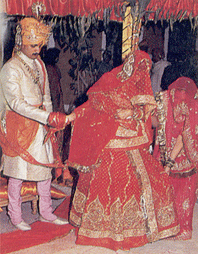
Welcome |
|
|
|
|
|
|
|
|
|
|
|
|
|
|
|
|
|
|
|
|
|
|
|
|
|
|
|
|
|
|
|
|
|
|
|
|
|
|
|
|
|
|
|
|
|
|
|
|
|
|
|
|
|
|
|
|
|
|
|
|
The origin of
the customs and traditions can be easily traced in the Vedas, where some
specific rituals and ceremonies are prescribed in detail. The customs and
traditions of Rajasthan are also based on the Vedic rituals. According to the
Vedas, every man and woman has to perform certain ceremonies, known as Sanskaars, from birth to death. There are sixteen Sanskaars and mainly relates
to three major events in one's life i.e., birth, marriage and death. The
birth, marriage and death are completely woven in the customs and traditions
of the people of Rajasthan. Although the birth of a son is considered as the
most welcome event, a daughter in the family is also considered essential. The
parents who are not blessed with a daughter to offer in marriage feel
themselves unfortunate, as Kanyadan, giving of daughter is considered as one
of the samskaras, without which one’s life is not considered complete.
|
|
|
Adoption in Rajasthan
|
|
Adoption is a common family practice in Rajasthan. Those who do not have male
children usually want to adopt a male child to continue their line of
succession. In Rajasthan, the Rajas and Maharajas used to adopt male child and
make them their successor with the consent of the British Viceroy in India.
Most of the Maharajas of Jaipur are the adopted sons. The ceremony of adoption
is quite simple. The elders of the family and community assemble at the
adopter's residence. They become the panch (elders of the family) at this
ceremony. In their presence, the adopted boy is covered with vermilion and a
coloured turban is placed on his head.
|
|
|
|
Religious Ceremonies in
Rajasthan |
|
The religious ceremonies starts from the conception, passes through birth and
marriage, and continues even after death. The people consider barrenness as a
great misfortune for a family so offerings are made to gods, treatments are
taken from wizards, talismans are worn around necks and many other ways are used to have a child. Once the pregnancy is established, all precautions are
taken to protect the mother from evil influences like charms are fastened
round the neck and waist and a knife is put under her pillow at night. She is
not allowed to go near mahua, khakra or khejara tree where spirits are
believed to reside. Various religious ceremonies begins and women sing songs
specially meant for such an occasion, some describing the changing behavior
and liking of a pregnant woman. During the pregnancy period the woman is given
some butter oil to drink to facilitate the delivery. A cow dung cake is kept
burning constantly, into which drops of butter oil and some incense is cast
from time to time and offerings are made to gods to ensure a safe and easy
child birth. Certain promises are made that if the child is safely born the
parents will take the infant to the deity and offer obeisance in person by
shaving off the hair on head of the baby. If the birth pains are excessive or
unbearable, the wizard's help is taken. Many women start wearing various charms as prescribed by wizards as soon as they realize that the pregnancy has
occurred.
When the child is born, its birth is announced by the wife of the family
barber or by the senior relatives or close friend. The naval cord of the child
is cut with a scythe and the child is rubbed with wheat flour and given a
bath. The cord and the placenta are buried carefully by the new father’s
sister to prevent their coming in the possession of any animal, evil spirit or
magician. The women ties strings of mango leaves at the doors of their house
and with the help of cow dung or red earth draws a swastika, a symbolic representation of Sun, as a sign of good wishes and good news. The woman is
given a partial bath after the delivery. On the sixth or seventh day, she is
given a regular bath and dressed ceremoniously and is brought out from the
delivery room with the baby by the younger brother of the husband to worship
the Sun. The baby is massaged with oil and kajal is put on the eye-line and a
red or blue string is tied round its waist. Both of them are are then taken in
a procession to the village well for worship called jalwa. After the child's birth various ceremonies are performed like the
Namkaran or Naming Ceremony and Mundan or Jaroola or Head Shaving Ceremony.
|
|
|
|
Namkaran or Naming Ceremony
|
|
The Namkaran ceremony is
performed either on the eleventh or on the one hundred and one day after the
birth of the child. The family priest is invited to perform the ceremony. He
recites mantras from the Vedas and gives his blessings to the child. The
family deity is also worshipped. A name is given to the child on this day. The
children are usually named after gods and goddesses. The women of the family
and the locality assemble, sing songs and offer their good wishes to the
child. Often, the first child is named as Jeewa or Amra and Jeevi or Jeevni,
Bhooli and Bhoondi. The children born to parents after they have lost quite a
few babies are also given some names like Kachra or Kachri. Sometimes the
parents who are blessed with a child after so much time, get the baby’s nose
pierced and name it as Nathu or Nathi and cover it with the old garments
received from the neighbours. Mangya, Rarha, Kajor, Ghasi, Chhaju and Ladhya
are some other names given by parents to the children who are born after long
time. |
|
|
|
Mundan
or Head Shaving Ceremony
|
|
The Mundan or
jadula ceremony is performed in the family when the male child is about two to
three years old. It is believed that the hair on the head of the boy, when he
is in the womb, is inspire and therefore should be shaved off. On an
auspicious day, the head of the boy is shaved with the chanting of Vedic
mantras. The village barber first worship his razor and then proceeds to shave
the infant’s head leaving a lock of hair. In most of the communities, the
bunch of hair at the top of the head is left from cutting. Sometimes this
ceremony is performed by some of the families in their ancestral temple. In
various other communities, the ear lobes of the children are generally pierced
when they are about five years old by the village goldsmith. The left nostril
and upper rim of the ears are also pierced in the girls. |
|
|
|
Wedding in
Rajasthan |
|
If there are two families with intense relationship, and the wives become the
pregnant during the same period, then an agreement is made between the parents
that if the children born are of opposite sex, they would be married to each
other. The infant marriage, a social evil which was once widely done in the
villages is still done in various communities. Akhateej, the third day of the
brought half of the month of May, is considered as the most auspicious day for
the wedding. The weddings are generally held on Dev Uthani Gyaras, Bharla
Naumi, Dhulandi, Basant Panchmi and Janmashtami as no priest or astrologer is
required to be consulted for the marriage. Whereas, a pandit is usually
consulted to recommend an auspicious time for the event. The auspicious time,
called the mahurat, is worked out by finding the most favourable alignment of
the lunar phase with the solar cycle and the conjunction of the nine planets.
The various ceremonies in a marriage generally starts with a ceremony called
sagai when the village barber, who may be accompanied by some near relatives,
proceeds to the boy’s residence, usually in a nearby village, along with some
money to be presented to the boy in the presence of people invited to witness
the function. The boy’s father then sends some clothes and a set of bangles
called chura for the girl. Later a date is fixed for the wedding, and a
turmeric coloured letter called lagan or peeli chitthi, is sent to the boy’s
home, through the barber informing about the mahurat and read before the
invited guests. Wedding atmosphere then prevails in both the families and
women assemble and sing songs of marriage describing the valour of the boy and
the beauty of the girl.
|
|
After a ceremonial bath on the wedding day the bride groom is adorned with a
special red or pink colour dress – a long jacket called angarkha, the tight
pyjamas or a dhoti, a turban mounted with a Kalgi, and ornamented shoes called
pagarkhi. A piece of red cloth is tied to the waist of the boy, and its free
end holds a coconut. Another piece of pink cloth is bordered with lace and
carried by the boy over his shoulders which is joined with the odhni, the veil
of the bride, when the marriage ceremony takes place. At an auspicious time,
the baraat leaves for the bride’s place. As the marriage party prepares to
leave for the bride’s place, the mother of the boy comes forward and publicly
suckles the bridegroom in a ceremony called boba dena. The party is received
on the outskirts of the village by close relatives of the bride and lodged in
a procession to the residence of the village potter, to worship wheel and to
fetch basan, bevra and kalash required for the marriage rituals. The bride’s
mother heads the procession on its way back
holding the kalash in her hands followed by five
suhagin carrying the other earthen vessels |
 |
|
on
their heads. Passing through the janwasa, women
sing a song noted for its melodic quality, called
jala. When the party reaches the bride’s house,
an important ceremony takes place. The bridegroom
touches toran, a wooden frame, which is fixed on
the main door of the bride’s place with his
ceremonial sword, sitting on the horse.
According to Rajput tradition, mandap, the wedding canopy is decorated with
the family weapons and processions are held, which people other than their own
kith and kin are not permitted to witness. The phera ceremony conducted by a
priest in the presence of the sacrificial fire then takes place when the
bridal couple goes round the fire seven times, where the bride lead the first
three round. After a sacrificial fire, the bride changes her seat from
the right to left of the bridegroom. After some other small ceremonies the
bridegroom returns home with the bride. |
|
|
|
|
|
|
|